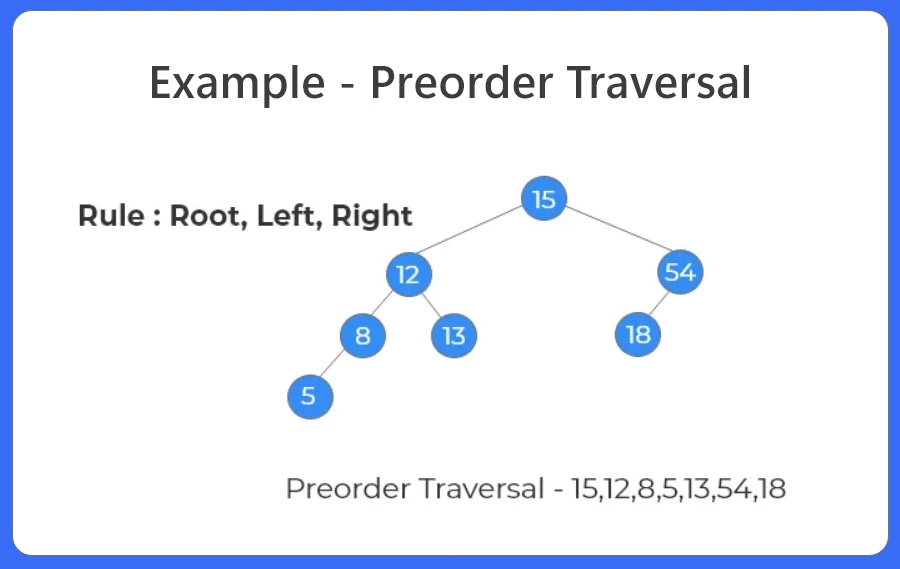Preorder Tree Traversal in Binary Tree In C++
Preorder Tree Traversal
Preorder Tree Traversal In Binary Tree in C++ – When working with binary trees, one of the most important tasks is to visit or traverse each node in a specific order. One such method is called Preorder Traversal. In this type of traversal, we follow the order: Root → Left → Right. This means we first visit the root node, then move to the left subtree, and finally to the right subtree.
Preorder traversal is especially useful when we want to create a copy of the tree or display its structure. Preorder traversal is a depth first algorithm. There are three types of traversals in tree: Preorder, Inorder, Postorder. In this article, preorder tree traversal is performed using recursion.

Preorder Tree Traversal in Binary Tree In C++
Preorder traversal is a method of visiting nodes in a binary tree following the Root → Left → Right sequence:
- First, the root node is visited, then the left subtree is explored recursively, and finally the right subtree is traversed in the same way.
More About Preorder Traversal
- We first print the value of the node,them move to the left subtree and finally to the right subtree.
- If we need to explore more about the node itself before inspecting its leaves, we use preorder traversal.
- Preorder traversal is used to find the prefix expression of an expression tree.


Steps To Find Preorder Traversal:
- Print the root node and traverse the left subtree.
- After printing 12, move to the left.
- 8 is printed and we move to the left subtree.
- Print 5 and move back,
- Since there is only 1 right child 13 is printed and we move to the right subtree.
- 54 and 18 are printed.
Algorithm To Find Preorder Traversal:
- If root is NULL, return NULL.
- Print the node.
- Visit left subtree.
- Visit right subtree.
Prime Course Trailer
Related Banners
Get PrepInsta Prime & get Access to all 200+ courses offered by PrepInsta in One Subscription
Code Implementation for Preorder Tree traversal
The code implementation for Preorder Tree Traversal processes nodes in the sequence: root, left subtree, and right subtree. It provides an efficient way to explore the entire tree structure while capturing the hierarchy from top to bottom. This approach is widely used in tasks like expression tree evaluation and tree based data serialization.
#include<bits/stdc++.h>
using namespace std;
class Tree
{
public:
int data;
Tree *left = NULL, *right = NULL;
// Constructor initialised
Tree (int x)
{
data = x;
left = NULL;
right = NULL;
}
};
void preorder_traversal (Tree * root)
{
if (root == NULL)
return;
// Print the data
cout << root->data << " "; // Visit Left subtree preorder_traversal (root->left);
// Visit right subtree
preorder_traversal (root->right);
}
int main ()
{
Tree *root = new Tree (15);
root->left = new Tree (12);
root->right = new Tree (54);
root->left->left = new Tree (8);
root->left->right = new Tree (13);
root->left->left->left = new Tree (5);
root->right->left = new Tree (18);
preorder_traversal (root);
return 0;
}
Output:
15 12 8 5 13 54 18
Explanation:
- A Tree class is created to store a node with a value and pointers to its left and right child, and each new node is initialized through a constructor.
- In main(), multiple Tree nodes are created manually and connected to form a binary tree structure with root value 15.
- The preorder_traversal function checks if the current node is NULL; if not, it prints the node’s value.
- After printing the current node, the function recursively visits the left subtree first and then the right subtree, following preorder logic.
- Finally, the traversal prints the tree nodes in the order they are visited: 15 12 8 5 13 54 18.
Time and Space Complexity:
| Operation / Traversal | Time Complexity | Space Complexity |
|---|---|---|
| Preorder Traversal | O(n) | O(h) |
| Worst Case (Skewed Tree) | O(n) | O(n) |
Best Case (Balanced Tre |
Conclusion
Preorder traversal is a simple and useful way to go through a binary tree. It visits the root first, then the left side, and finally the right side. This method is helpful when you want to print the structure of the tree or create a copy of it. Both recursive and iterative approaches are easy to learn with some practice.
FAQs - Preorder Tree Traversal in Binary Tree In C++
FAQs - Preorder Tree Traversal in Binary Tree In C++
No, preorder traversal alone is not enough to reconstruct a binary tree uniquely. To fully reconstruct the tree, you need preorder along with either inorder or postorder traversal. This is because preorder only shows the order of visiting, not the exact structure of left and right subtrees.
- Recursive approach uses the function call stack, so its space complexity is O(h), where h is the height of the tree.
- Iterative approach uses an explicit stack and also takes O(h) space. In a skewed tree, this could go up to O(n) in the worst case.
Preorder traversal is commonly used for:
- Cloning or copying a tree
- Serializing tree data into a file or string
- Evaluating or printing prefix expressions from expression trees
- Generating structured outputs like XML or JSON from hierarchical data
In the iterative method, a stack is used to simulate recursion:
- Start by pushing the root node onto the stack.
- While the stack is not empty:
- Pop a node, process it (print/store value),
- Push its right child (if any),
- Then push its left child (if any).
- We push right before left because stacks are LIFO, and we want to process the left child first.
Yes, using Morris Traversal, it’s possible to perform preorder traversal in O(1) space, without recursion or a stack. However, this method temporarily modifies the tree structure by creating threaded links and is more complex to implement.
Preorder traversal works on any binary tree, including binary heaps or complete binary trees. However, in heaps, level-order traversal is more relevant since heaps are typically represented as arrays, and Preorder does not maintain the heap structure when traversing.
Get over 200+ course One Subscription
Courses like AI/ML, Cloud Computing, Ethical Hacking, C, C++, Java, Python, DSA (All Languages), Competitive Coding (All Languages), TCS, Infosys, Wipro, Amazon, DBMS, SQL and others
Introduction to Trees
Binary Trees
- Binary Tree in Data Structures (Introduction)
- Tree Traversals: Inorder Postorder Preorder : C | C++ | Java
- Inorder Postorder PreOrder Traversals Examples
- Tree Traversal without Recursion
Binary Search Trees
Traversals
- Traversal in Trees
- Tree Traversals: Breadth-First Search (BFS) : C | C++ | Java
- Tree Traversals: Depth First Search (DFS) : C | C++ | Java
- Construct a Binary Tree from Postorder and Inorder
B – Trees
AVL Trees
- AVL Trees
Complete Programs for Trees
- Depth First Traversals – C | C++ | Java
- Level Order Traversal – C | C++ | Java
- Construct Tree from given Inorder and Preorder traversals – C | C++ | Java
- Construct Tree from given Postorder and Inorder traversals – C | C++ | Java
- Construct Tree from given Postorder and Preorder traversal – C | C++ | Java
- Find size of the Binary tree – C | C++ | Java
- Find the height of binary tree – C | C++ | Java
- Find maximum in binary tree – C | C++ | Java
- Check whether two tree are identical- C| C++| Java
- Spiral Order traversal of Tree- C | C++| Java
- Level Order Traversal Line by Line – C | C++| Java
- Hand shaking lemma and some Impotant Tree Properties.
- Check If binary tree if Foldable or not.- C| C++| Java
- check whether tree is Symmetric – C| C++| Java.
- Check for Children-Sum in Binary Tree- C|C++| Java
- Sum of all nodes in Binary Tree- C | C++ | Java
- Lowest Common Ancestor in Binary Tree- C | C++ | Java
Introduction to Trees
Binary Trees
- Binary Tree in Data Structures (Introduction)
- Tree Traversals: Inorder Postorder Preorder : C | C++ | Java
- Inorder Postorder PreOrder Traversals Examples
- Tree Traversal without Recursion
Binary Search Trees
Traversals
- Traversal in Trees
- Tree Traversals: Breadth-First Search (BFS) : C | C++ | Java
- Tree Traversals: Depth First Search (DFS) : C | C++ | Java
- Construct a Binary Tree from Postorder and Inorder
B – Trees
AVL Trees
- AVL Trees
Complete Programs for Trees
- Depth First Traversals – C | C++ | Java
- Level Order Traversal – C | C++ | Java
- Construct Tree from given Inorder and Preorder traversals – C | C++ | Java
- Construct Tree from given Postorder and Inorder traversals – C | C++ | Java
- Construct Tree from given Postorder and Preorder traversal – C | C++ | Java
- Find size of the Binary tree – C | C++ | Java
- Find the height of binary tree – C | C++ | Java
- Find maximum in binary tree – C | C++ | Java
- Check whether two tree are identical- C| C++| Java
- Spiral Order traversal of Tree- C | C++| Java
- Level Order Traversal LIne by Line – C | C++| Java
- Hand shaking lemma and some Impotant Tree Properties.
- Check If binary tree if Foldable or not.- C| C++| Java
- check whether tree is Symmetric C| C++| Java.
- Check for Children-Sum in Binary Tree- C|C++| Java
- Sum of all nodes in Binary Tree- C | C++ | Java
- Lowest Common Ancestor in Binary Tree. C | C++ | Java




Login/Signup to comment